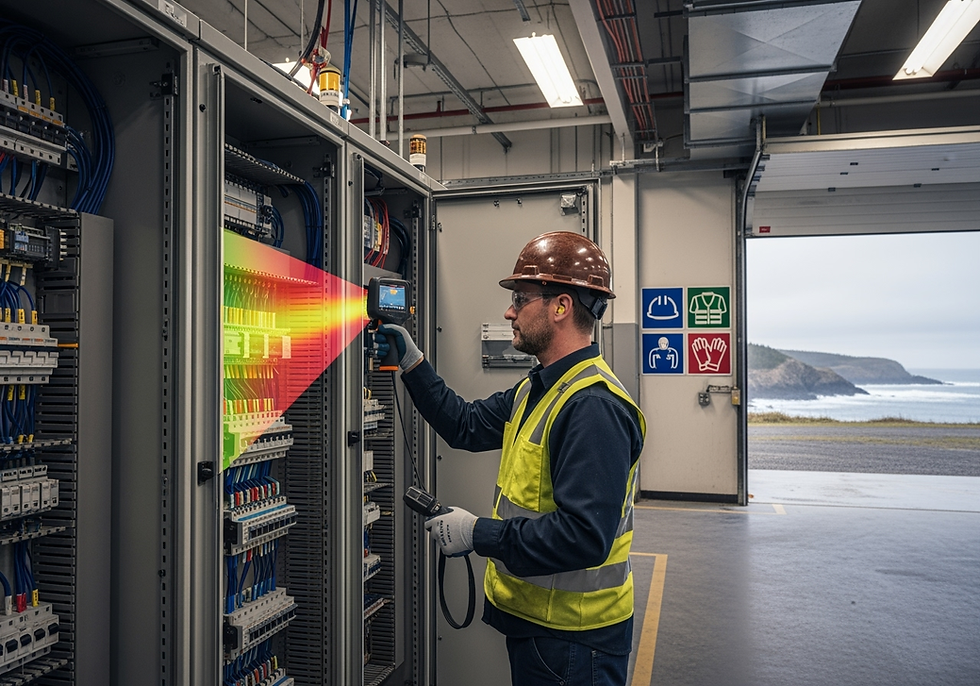How Drone Inspections Are Changing Facility Maintenance in Atlantic Canada
- Mike Holloway
- Aug 12
- 3 min read
Facility maintenance in Atlantic Canada is facing new challenges: aging buildings, harsh weather, and increased safety and compliance demands. One technology that’s quietly transforming how property owners and facility managers address these issues is drone-based inspection.
What Are Drone Inspections?
Drone inspections use unmanned aerial vehicles (UAVs) equipped with advanced cameras—both visual and thermal—to assess the condition of buildings, roofs, electrical systems, and other assets. Instead of relying on ladders, scaffolding, or lifts, inspectors can now collect data from the ground, reducing risk and increasing the reach of each inspection.
There are many drones on the market today capable of capturing high-resolution images and thermal data in a single flight. This means inspectors can identify not just visible issues, but also hidden problems like heat loss, moisture intrusion, and electrical faults.
Why Are Drones Useful for Facility Maintenance?
1. Safety Improvements
Traditional inspections often require technicians to access hazardous areas—roofs, towers, or confined spaces. Drones eliminate much of this risk. Inspections can be performed while keeping personnel safely on the ground, reducing the chance of accidents.
2. Access to Difficult Areas
Some parts of a facility are simply hard to reach. Drones can fly over large roofs, around tall structures, or into tight exterior spaces that would otherwise require expensive and time-consuming access equipment.
3. Comprehensive Data Collection
Drones gather both standard and thermal images, providing a complete view of the asset’s health. For example, a thermal camera can reveal heat escaping from a building envelope or an overheating electrical component that would be invisible to the naked eye.
4. Efficiency and Documentation
Because drones can cover large areas quickly, inspections take less time and cause less disruption to normal operations. The data collected can be compiled into detailed reports, complete with images and thermal readings, making it easier to document asset conditions for maintenance planning or insurance compliance.
What Issues Can Drone Inspections Detect?
Heat Loss: Thermal imaging can spot insulation failures or gaps in building envelopes.
Moisture Intrusion: Water leaks and trapped moisture often show up as temperature anomalies.
Electrical Faults: Overheating electrical components, loose connections, or overloaded circuits can be identified before they cause failures.
Roof Damage: Visual and thermal data can highlight damaged or deteriorating roofing materials.
Structural Concerns: Cracks, corrosion, or other visible signs of wear can be documented for further assessment.
Regulatory and Technical Considerations
Operating drones for commercial inspections isn’t as simple as just flying a hobby drone. In Canada, drone pilots must have advanced certification and comply with NAV Canada regulations. Drones must be registered, and operators need to carry appropriate insurance. At Quantum, all flights are conducted by certified pilots and in line with these requirements.
When Should a Facility Consider Drone Inspections?
Routine Preventative Maintenance: As part of an annual or biannual maintenance schedule.
After Severe Weather: To assess damage from storms, wind, or heavy snowfall.
When Access is Limited: If physical access is risky or cost-prohibitive.
For Insurance Renewals: When up-to-date documentation is required.
Limitations and Best Practices
While drones are powerful tools, they’re not a complete replacement for hands-on inspection. Some issues may still require close-up, manual assessment. However, drone data can help prioritize which areas need further investigation, making overall maintenance more targeted and efficient.
Best practices include:
Ensuring drones and cameras are properly maintained and calibrated
Using standardized reporting templates for consistency
Integrating drone findings with other inspection and maintenance records
In Summary:
Drone inspections bring a new level of safety, efficiency, and insight to facility maintenance in Atlantic Canada. By combining visual and thermal imaging, they help property owners and managers detect problems early, plan repairs more effectively, and maintain compliance with industry standards.





Comments